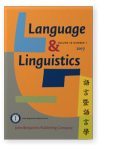Vol. 18:1 (2017) ► pp.72–115
Acquisition of Chinese relative clauses by deaf children in Hong Kong
This paper is a study of how deaf children in Hong Kong acquire Chinese relative clauses. The relative clause is reported to be a difficult structure for deaf children (Friedmann & Szterman 2006). While it may be true for postnominal relative clauses, it is unclear whether prenominal relative clauses are equally difficult for deaf children. This paper explores this question by examining deaf children’s comprehension and production of Chinese relative clauses via an elicited production task, a picture selection task and a dots-connecting task, which are all presented in written format. In addition to deaf children, typically developing Cantonese children and Cantonese adults with high Chinese proficiency are also recruited for comparison. The results show that deaf children fall behind typically developing Cantonese children in production. But deaf children with higher Chinese proficiency can perform similarly with typically developing Cantonese children. The error types and the types of non-RC responses produced by deaf children are also present in the data of typically developing Cantonese children, suggesting that deaf children do not undergo a different pathway in the development of relative clauses. While typically developing Cantonese children demonstrate non-significant subject advantage in production but object advantage in comprehension, deaf children do not demonstrate subject-object asymmetry in production and object advantage in comprehension.
Article outline
- 1.Introduction
- 1.1Acquisition of relative clauses
- 1.1.1Typically developing children
- 1.1.2Deaf children
- 1.2Chinese relative clauses
- 1.3Acquisition of Chinese relative clauses
- 1.1Acquisition of relative clauses
- 2.Experiment 1: Elicited production
- 2.1Participants
- 2.2Test design and procedures
- 2.3Results
- 2.3.1Adults
-
2.3.2Typically developing Cantonese children
- 2.3.2.1Adult-like RC responses
- 2.3.2.2Non-adult-like RC
- 2.3.2.3Non-RC responses
- 2.3.3Deaf children
- 2.3.3.1RC responses and errors
- 2.3.3.2Subject-object asymmetry?
- 2.3.3.3Non-RC responses
- 3.Experiment 2: Comprehension tests
- 3.1Participants
- 3.2Method and test procedures
- 3.3Results
- 3.3.1Adults
- 3.3.2Typically developing Cantonese children
- 3.3.3Deaf children
- 4.Overall results
- 5.Discussion and conclusions
- Acknowledgements
- Notes
-
References
For any use beyond this license, please contact the publisher at [email protected].
